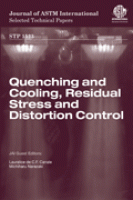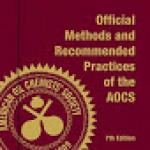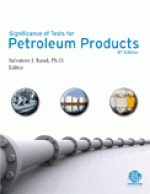Descrição
Contents
Experimental Technique for Heat Transfer Measurements on Fast Moving Sprayed Surfaces
Pohanka M., Bellerova H., Raudensky M.
Accurate Determination of Surface Heat Fluxes during Quenching Characterized by Boiling Water Heat Transfer
Wells M., Daun K.
Heat Transfer during Quenching and Assessment of Quench SeverityA Review
Prabhu K., Fernandes P.
Formulation of a Guideline for the Determination of Heat Transfer Coefficient during Gas Quenching
Luebben T., Lohrmann M., Segerberg S., Sommer P.
Determination of Surface Heat Transfer Coefficients of Cr12MoV Steel Cylinder during High-Speed Gas Quenching at Atmospheric Pressure
Cheng H., Li J., Li Z., Hou L., Hou J.
Enhancement and Local Regulation of Metal Quenching Using Atomized Sprays
Alam U., Krol J., Specht E., Schmidt J.
The Effect of Agitation and Quenchant Temperature on the Heat Transfer Coefficients for 6061 Aluminum Alloy Quenched in Distilled Water
Maniruzzaman M., Fontecchio M., Sisson R.
A Review on Modeling and Simulation of Quenching
Şimşir C., Gür C.
Modeling of Quenching and Tempering Induced Phase Transformations in Steels
Rajeev P., Jin L., Farris T., Chandrasekar S.
Improving Control of a Quenching Process by Coupling Analysis Methods
Banka A., Franklin J., Li Z., Ferguson B., Freborg A., Aronov M.
Generalized Equation for Cooling Time Evaluation and Its Verification by CFD Analysis
Krukovskyi P., Kobasko N., Yurchenko D.
Computer Simulation of Quenched Steel Working Stress
Smoljan B., Hanza S., Iljkić D.
A Novel Approach to Model Moving Heat Sources
Fischer F., Krempaszky C., Očenáek J., Očenáek J., Werner E.
Analysis of Stress Concentration around Inclusions Due to Thermally Induced Strain to the Steel Matrix
Allazadeh M., Garcia C., DeArdo A., Lovell M.
Considering the Body-Centered Cubic Lattice Parameter of α-Fe Alloys versus Concentrations of Solved Elements
Filippova V.
Application of Thermodynamics and Kinetics in the Designing of New Type TRIP Steels Concerning Al and P Effects
Li L., Huang S., Wang L., He Y., Vleugels J., Van der Biest O.
Model of Solid State Transformations of Ductile Cast Iron GJS-600
Runser V., Schulze V.
Using Polyalkylene Glycol Quenchants to Effectively Control Distortion and Residual Stresses in Heat Treated Aluminum Alloys
Croucher T.
Minimizing Machining Distortion in Aluminum Alloys through Successful Application of Uphill QuenchingA Process Overview
Croucher T.
Explanation of the Origin of Distortion and Residual Stress in Carburized Ring Using Computer Simulation
Arimoto K., Yamanaka S., Funatani K.
The Analysis and Control of Distortion in Carbonitrided and Nitrocarburized Thin-Shelled Plain Carbon Steel Automotive Powertrain Components
Campagna V., Northwood D., Bowers R., Sun X., Bauerle P.
The Effect of Core and Carburized Surface Microstructural Stability on Residual Stress Evolution during Tempering
Vatavuk J., di Monte M., Couto A.
Explanation on the Origin of Distortion in Induction Hardened Ring Specimens by Computer Simulation
Horino T., Ikuta F., Arimoto K., Jin C., Tamura S.
Optimum Strategies to Reduce Residual Stresses and Distortion during the Metal Quenching Process
Nallathambi A., Kaymak Y., Specht E., Bertram A.
Numerical Simulation of Residual Stresses in Quenched Steel Bodies Using Subroutines to Represent TTT and CCT Diagrams
Bortoleto E., Lagatta C., Cuppari M., Machado I., de Souza R.
Prediction of Distortion of Automotive Pinion Gears during Quenching Using CFD and FEA
MacKenzie D., Kumar A., Metwally H., Paingankar S., Li Z., Ferguson B.
Prediction of Quench-Hardness within the Whole Volume of Axially Symmetric Workpieces of Any Shape
Ličić B., Singer S., Smoljan B.
Correlation between Thermal and Mechanical Properties of the 10NiCr11
Ghrib T., Bouhafs M., Yacoubi N.
An Efficient Numerical Algorithm for the Prediction of Thermal and Microstructure Fields during Quenching of Steel Rods
Ali S., Ali S., Hamed M., Hamed M., Lightstone M.
Starch-Based Quenchants as an Eco-Friendly Alternative to Quenching Oil
Sahay S.
Comparison of Structure and Quenching Performance of Vegetable Oils
de Souza E., Fernandes M., Augustinho S., de Campos Franceschini Canale L., Totten G.
Severity of Quenching and Kinetics of Wetting of Nanofluids and Vegetable Oils
Jagannath V., Prabhu K.
An Investigation on Quenching Performance of Hot Alkaline Bath
Raygan S., Rassizadehghani J., Askari M.
A Feasibility Study of the Use of Bismuth Bath to Replace Lead Bath as the Quenching Media for Steel Heat-Treating
Ru J., Wang Z.
Spray Quenching in Induction Hardening Applications
Rudnev V.
Technology and Applications of Alternately Timed Quenching Technology
Chen N., Zuo X., Zhou S., Xu J.
One More Discussion What is Intensive Quenching Process?
Kobasko N., Aronov M., Powell J., Totten G.
Energy Efficient and Eco-friendly Intensively Quenched Limited Hardenability Low Alloy Steels
Kobasko N.
An Overview of Technology and Equipment for Hardening of Large Steel Parts
Deyneko L., Kobasko N., Dobryvechir V., Litvinenko E.
Accelerated Cooling of Steel Plates: The Time Has Come
Gorni A., Dolabela da Silveira J.
Overview of Pearlitic Rail Steel: Accelerated Cooling, Quenching, Microstructure, and Mechanical Properties
Sahay S., Mohapatra G., Totten G.
Water and Polymer Quenching of Aluminum Alloys: A Review of the Effect of Surface Condition, Water Temperature, and Polymer Quenchant Concentration on the Yield Strength of 7075-T6 Aluminum Plate
Sarmiento G., Sarmiento G., Bronzini C., Canale A., Canale L., Totten G.
Gas-Jet Quenching
Stratton P.
Quenching Homogeneity and Intensity Improvement in Batch Mode High Pressure Gas Quenching
Schmidt R., Fritsching U.
Gas-Cooling of Multiple Short Inline Disks in Flow along Their Axis
Lior N., Papadopoulos D.
Numerical Simulation of the Mechanical Properties of Cr12 Steel during Gas Quenching
Li Z., Cheng H., Li J., Hou L.
Enhanced Hardenability through Application of Magnetic Fields
Machado I.
A New Method to Study the Effect of Cooling Rate on the Decomposition of Austenite in Advanced High Strength Sheet Steels
Cho K., Garcia C., Hua M., Lee J., Ahn Y., DeArdo A.
Quenchant Characterization by Cooling Curve Analysis
Canale L., Luo X., Yao X., Totten G.
Cooling Characteristic Test of Quenching Media
Zeng G.
A Complete System for Testing and Evaluation of Quenchants and Quenching Systems
Kristoffersen H., Troell E., Felde I., Bodin J.
Effects of Cooling Rate Fluctuation on Cooling and Transformation Behavior of Steel upon Direct Quenching
Luo X., Li J.
Correlation between Cooling Curves Obtained with a Silver Probe and Quenching Properties of 5140 Steel Bars
Wang R., Wang Y., Su L.
Measurement of the Cooling Power of Polyethylene Glycol Aqueous Solutions Used as Quenching Media
Ikkene R., Ikkene R., Koudil Z., Mouzali M.
Evolution of Quench Factor Analysis: A Review
Kavalco P., Canale L.
Analysis of the Segerberg Hardening Power Equation
Chun-huai C., Jing-en Z.
The Influence of Surface Temperature on Rewetting Behavior During Immersion Quenching of Hollow and Solid Cylinders
Frerichs F., Luebben T.
Dilatometric Analysis to Study Aging of Aluminum Alloys
Gerosa R., Rivolta B., Derudi U.
Optimization of the Heat Treatment of a 17-4 PH Stainless Steel by Dilatometric Technique
Gerosa R., Rivolta B., Sala A.
Author Index
Subject Index




